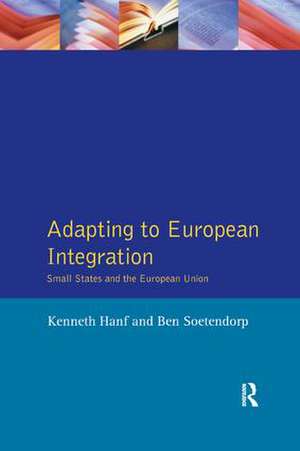Adapting to European Integration: Small States and the European Union
Autor Kenneth Hanfen Limba Engleză Hardback – 22 noi 2017
The study makes a distinction between governmental/administrative adaptation, political adaptation and strategic adaptation. The chapters focus, in the first instance, on the governmental/administrative responses at the level of central government, the organisational adjustments and the changes in institutional capacity to meet the new challenges. The authors also look at the willingness of the political decision-makers to internalise the EC/EU dimension in domestic policy making and the way in which the country's own history as well as the attitude towards European integration facilitate or hinder adaptation and change.
Preț: 1044.68 lei
Preț vechi: 1480.84 lei
-29% Nou
Puncte Express: 1567
Preț estimativ în valută:
199.96€ • 217.28$ • 168.08£
199.96€ • 217.28$ • 168.08£
Carte tipărită la comandă
Livrare economică 21 aprilie-05 mai
Preluare comenzi: 021 569.72.76
Specificații
ISBN-13: 9781138458925
ISBN-10: 1138458929
Pagini: 218
Dimensiuni: 156 x 234 x 20 mm
Greutate: 0.57 kg
Ediția:1
Editura: Taylor & Francis
Colecția Routledge
Locul publicării:Oxford, United Kingdom
ISBN-10: 1138458929
Pagini: 218
Dimensiuni: 156 x 234 x 20 mm
Greutate: 0.57 kg
Ediția:1
Editura: Taylor & Francis
Colecția Routledge
Locul publicării:Oxford, United Kingdom
Cuprins
Small States and the Europeanisation of Public Policy Belgium: The Dilemma Between Cohesion and Autonomy The Netherlands Denmark: The Testing of a Hesitant Membership Ireland: The Rewards of Pragmatism Greece: Competing Regional Priorities Spain: Modernisation Through Integration Austria: Adaptation Through Anticipation Sweden: The State Joins the European Union Norway: An Adaptive Non-Member Switzerland: Adjustment Despite Deadlock Conclusions: The Nature of National Adaptation to European Integration
Descriere
This text describes how the political institutions of eight small member states and two non-member states have responded to the internal and external demands springing from the process of European integration in general and EC/EU membership in particular.
